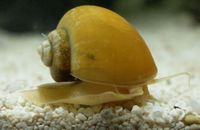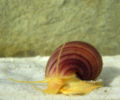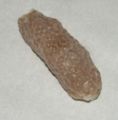Golden Apple Snail (Pomacea bridgesii)
Golden Apple Snail
Pomacea bridgesii
19 Litres (5 US G.)
5.1-6.4cm (2-2.5 ")
Freshwater
7.0 - 8.0
20 -28 °C (68-82.4°F)
8-15 °d
1:1 M:F
1-2 years
This animal is available captive bred
Contents
Alternative names[edit]
- Apple Snail, Golden Apple Snail, Mystery Snail
Origin[edit]
- Native to Bolivia, Paraguay, Peru, and Brazil. Non-native populations in Southeast Asia.
Sexing[edit]
- Difficult, these are NOT hermaphroditic snails. Female grows faster than the male at first. In male snails the shell opening tends to be larger and rounder, due to the penial complex (easier to see in large numbers). It is easier to estimate the sex by looking inside the shell opening to see the penial complex. This will not be visible in females. Just take the snail out of the water and keep it upside down. The snail will stretch its foot out (as if it is trying to flip over). Once it has extended out to a point, If you look to the right of the mantle, You should see a large penis sheath in front of the gills. In a female snail the sheath will be absent.
Breeding[edit]
- When 2 snails are mating, it's the female which is the lower of the pair. Female lays the eggs, which are bright pink in colour, above the water at night so it's easy to control population. Eggs hatch out after 2-3 weeks. Egg clusters need to be kept at a high humidity and at 22-28°C (71.6-82.4°F) . High temperature causes earlier hatching.
Tank compatibility[edit]
- Will mix with virtually any other non-predator aquatic animal. Do not keep with Loaches or Puffer Fish and other invert eaters as they will attack and possibly kill the snail.
Diet[edit]
- Eats par-boiled vegetables, likes peeled grapes, will eat a little algae. This snail will generally not eat live plants. Do not be shocked if you see this snail eating a recently dead creature, they are opportunists.
Feeding regime[edit]
- It will constantly graze around the tank or will eat algae tablets. Apple snails can also be fed par-boiled leafy greens.
Environment Specifics[edit]
- Apple snails are more active during the night when the tank lights are switched off.
- Must have calcium ( GH greater than 8d) in the water and a pH greater than 7.0 or the shell will dissolve and the snail will die.
- If it is kept at the higher temperature range, it will move around more quickly, but will have a shorter life span of about a year.
- Any copper based medical treatments in the water will kill it.
- Does not like salt.
- The condition of its shell shows the history of its life:
The intensity of the colours (and the visibility of the stripes) can sometimes change because of environmental factors. This new look is not applied to the whole shell, only to the expanding of it, giving you a clear reading of a snails environmental history just by looking at its shell-patterns. Also, periods of acidity or too little calcium damages the shell, and may give it a roughened texture or even holes. The shell never heals, which is why it is common to see some visible wear, maybe even some small breakage around the oldest part (the tip). This is is common to all snails.
Behaviour[edit]
- A graceful and peaceful animal, it is a bottom feeder, although it explores all over the aquarium. It does however need to breathe air from the surface. It has a tube (also called a siphon) which it can extend to allow it to breathe air whilst remaining underwater.
Identification[edit]
- Shape of body, and shape and colour of shell are the biggest clues, especially if you can see the stripes.
- The albino variant is the most common in shops, and should have yellow-white flesh with orange spots and a golden yellow shell.
- The natural variant has a brown, striped shell and a dark flesh.
- Mixtures can produce different variants of coloring on shell and flesh, including pink, ivory, blue and jade.
- They have stripes parallel to the spiral shape of the shell, but the stripes are not always visible.



